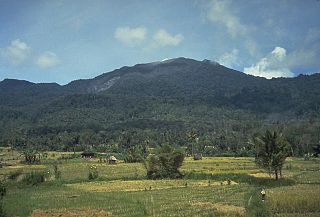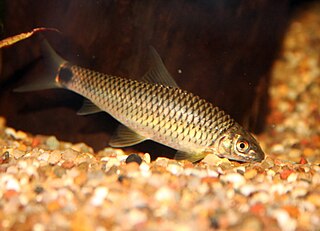
The bala shark, Balantiocheilos melanopterus, also known as the tricolor shark, tricolor sharkminnow, silver shark, or shark minnow, is a fish of the family Cyprinidae, and is one of the two species in the genus Balantiocheilos. This species is not a true shark, but is commonly so called because of its torpedo-shaped body and large fins.

Balantiocheilos is a small genus of cyprinid fish from southeast Asia. It includes two species.

The Siamese algae-eater is a species of freshwater fish in the carp family, Cyprinidae. This bottom-dwelling tropical fish is found in mainland Southeast Asia, including the Chao Phraya and Mekong basins as well as the Malay Peninsula. Its natural habitats are streams and rivers as well as flooded forests during the rainy season. The Siamese algae-eater should not be confused with the flying fox or the false siamensis , lacking the distinctive black bands of the former.
Crossocheilus klatti, also known as the Isparta minnow or Anatolian golden barb, is a species of ray-finned fish in the genus Crossocheilus. It is found in the Lake Işıklı basin in the Büyük Menderes drainage in Turkey. There is some confusion regarding the identity of this fish. This poorly known species is closely related to Garra kemali, and likely should be placed in that genus.

The Batang Hari is the longest river in Jambi province, Sumatra island, Indonesia, about 600 kilometres (370 mi) northwest of the capital Jakarta.

Batang Gadis is a national park covering 1,080 km2 in North Sumatra province, Indonesia extending between 300 and 2,145 metres altitude. It is named after the Batang Gadis river that flows thorough the park. Signs of the endangered Sumatran tiger and the threatened Asian golden cat, leopard cat and clouded leopard were seen in the park. The protection of Batang Gadis as a national park is part of a plan to create the Northern Sumatra biodiversity conservation corridor, which would be connected, via a series of protected areas and forests, to Gunung Leuser National Park in the north of the island.
Nemacheilus papillos is a species of cyprinid fish. It occurs in Indonesia and Peninsular Malaysia. It is a demersal species that inhabits tributary and larger rivers.
Pangio atactos is a species of cyprinid fish. It is endemic to Sumatra (Indonesia) and only known from the upper reaches of the Batang Hari River basin. It is a demersal species that occurs in both rivers and lakes.
Pangio bitaimac is a species of cyprinid fish. It is endemic to Java (Indonesia) and only known from the Batang Hari River basin. It occurs in small tributary freshwater streams.

Crossocheilus, also known as the fringe barbs, flying foxes, or "algae eaters", is a genus of fish in the family Cyprinidae. It is distributed in China, India, Indonesia, Malaysia and Thailand in Asia. These fish occur in several types of habitat, often fast-flowing rivers with rocky bottoms.
Crossocheilus periyarensis is a species of fish in the family Cyprinidae. This species is only found in Periyar River in Kerala, India.
The longfin gurnard, the long-finned gurnard or shining gurnard, is a species of ray-finned fish belonging to the family Triglidae, the gurnards and sea robins. This fish is found in the eastern Atlantic Ocean, including the Mediterranean Sea and the Black Sea. This species is of commercial importance as a food fish.

Crossocheilus atrilimes is a species of freshwater fish in the family Cyprinidae. It is found in Laos, in Thailand, and in Cambodia.

Crossocheilus reticulatus is a freshwater fish in the family Cyprinidae from Southeast Asia. It grows to 17 cm (6.7 in) standard length.
Pectenocypris micromysticetus is a species of cyprinid fish. It is endemic to Sumatra (Indonesia). It is known only from the Batang Hari River basin. It is common in oxbow lakes and still pools in open or recently flooded areas.
Osteochilus kerinciensis is a species of cyprinid fish. It is endemic to Sumatra (Indonesia). It is known from the upper reaches of the Batang Hari River basin, including upstream tributaries and highland lakes. The specific name kerinciensis refers to its type locality, Lake Kerinci.
Crossocheilus nigriloba is a species of ray-finned fish in the genus Crossocheilus. It is native to eastern Borneo.
The Antakya minnow is a species of ray-finned fish in the genus Crossocheilus. There is some confusion regarding the identity of this fish. Fishbase identifies the species as extinct, formerly occupying the Orontes watershed in Turkey, however a synonym, Hemigrammocapoeta caudomaculata is identified as least concern by the IUCN, and is found in the Asi drainage in Turkey and Syria and Nahr al-Kabir at the border between Syria and Lebanon, and called the Asi golden barb. They may be distinct species.

Crossocheilus latius, also known as the stone roller or Gangetic latia, is a species of ray-finned fish in the genus Crossocheilus. It is found in India, Bangladesh, Myanmar, Nepal, and China.
Luciocephalus aura, sometimes called the green-spotted pikehead or peppermint pikehead, is a species of freshwater ray-finned fish from the subfamily Luciocephalinae of the gourami family Osphronemidae. It is endemic to Sumatra where it has been recorded from the middle Batang Hari River and from the middle Musi River drainage. An undescribed similar taxon has been seen in central Kalimantan and this is possibly a third species in the genus Luciocephalus. On Sumatra Luciocephalus aura and l. pulcher are both found in the same areas but they appear to be syntopic with L. aura preferring the faster flowing habitats. It is an ambush predator and paternal mouthbrooder. It has a line of bright green spots along its flanks which distinguish it from L. pulcher.









